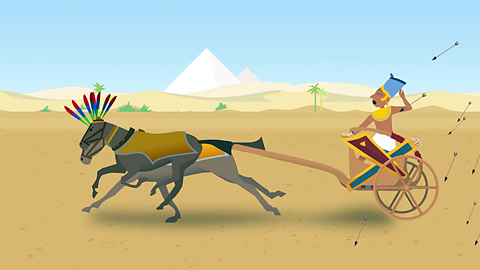What are hieroglyphs?
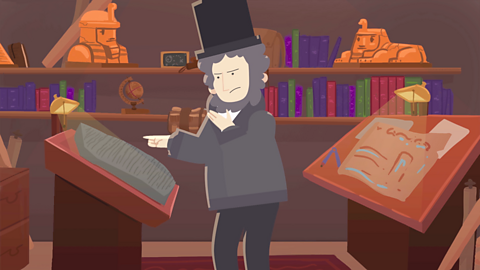
- Hieroglyphs are symbols that show words and sounds.
- The ancient Egyptians invented a writing system using hieroglyphs in about 3000 BC.
- They had about⯠700âŻdifferent signs for objects and animals.
- The people who wrote hieroglyphs were calledâŻscribes.
- They went to a special school to learn all the symbols.

The hieroglyph alphabet
- This is the closest version to our modern English alphabet.
- There were no symbols for vowels (âaâ, âeâ, âiâ, âoâ or âuâ), so the alphabet below shows the closest sounds.
What is the Rosetta stone?
- The Rosetta stone was discovered in 1799.
- It is a three-foot high stone containing hieroglyphs, everyday ancient Egyptian language and a Greek translation.
- Egyptologists translated the Greek into modern European languages.
- Then they used those words to understand the ancient Egyptian hieroglyphs.
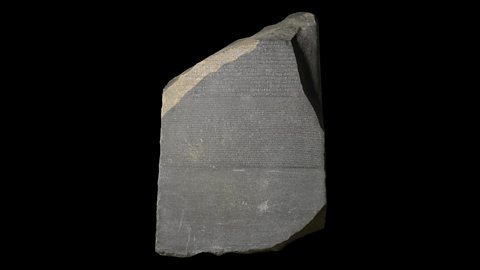 Image source, The Trustees of the British Museum
Image source, The Trustees of the British MuseumWhere have we found hieroglyphs?

Hieroglyphs can be seen on tombs, pottery and walls on ancient Egyptian remains.
They tell us about beliefs, gods, clothing and everyday life.
The ancient Egyptians also used papyrus and writing boards to keep records of thing like laws.
This is different from societies living at the same time who used no writing, such as the people who built Stonehenge.

Examples of hieroglyphs
- Image source, The Metropolitan Museum Of Art, New York
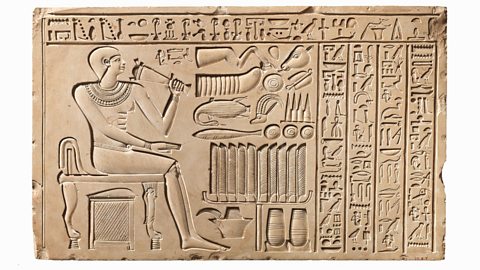
Image caption, Stone carving of Gatekeeper Maati, ca. 2051â2030BC
In this image an official of Pharaoh Mentuhotep II called Maati sits in front of an offering table. It looks like a carving related to a funeral because the table is a stand with tall leaves. Food offerings float above the table and below it is a bowl for Maati to wash himself. The hieroglyph text on the right are traditional passages carved to remember the dead.
- Image source, The Metropolitan Museum Of Art, New York
Image caption, Hands offering Aten writing tablets, ca. 1352â1336BC
This piece was found in the Sanctuary of the Great Aten Temple. Aten's name is written inside the two oval shapes that you can see on the front.
- Image source, The Metropolitan Museum Of Art, New York
Image caption, Book of the Dead for the Singer of Amun, Nany, ca. 1050BC
This is a section from a piece of papyrus (ancient Egyptian paper) that was over 17 feet long. It shows a singer named Nany on her journey into the afterlife. The hieroglyphs are phrases from the 'Book of the Dead'. Nany is at the final stage in her journey into the afterlife. She is at the Hall of Judgement, standing in front of Osiris, the God of the Underworld.
- Image source, The Metropolitan Museum Of Art, New York
Image caption, Stone carving of Userhat,1327â1295BC
On this piece of stone, a priest called Userhat talks about all of his good qualities and about his trust in a god called Amun. He is shown here kneeling down with his wife who is called Nefertari.
- Image source, The Metropolitan Museum Of Art, New York
Image caption, Stone carving of the Overseer of the Fortress Intef, ca. 2000â1988BC
On the top line of this piece is the name of King Nebhepetre Mentuhotep II. The owner of this piece is a man named Intef. In the hieroglyphs, he says he is the king's servant and in charge of a fortress.
1 of 5
Activities
Use the hieroglyph alphabet below to help you complete the activities.

Activity 1: Spell with hieroglyphs
Use the hieroglyph alphabet above to help you spell the word.
Activity 2: Crack the hieroglyph code
Activity 3: Write your name in hieroglyphs
Download the ancient Egyptian alphabet and try to copy them. Can you write your name in hieroglyphs?

Activity 4: Hieroglyph quiz
Activity 5: History Explorer game
Play this game to test your knowledge and learn even more facts about Ancient Egypt.
History Explorer: Secrets through time
History Explorer: Secrets through time: KS2 History

Bitesize Primary games. gameBitesize Primary games
Play fun and educational primary games in science, maths, English, history, geography, art, computing and modern languages.

More on Ancient Egypt
Find out more by working through a topic
- count18 of 18
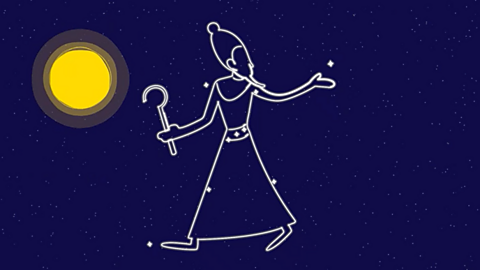
- count1 of 18
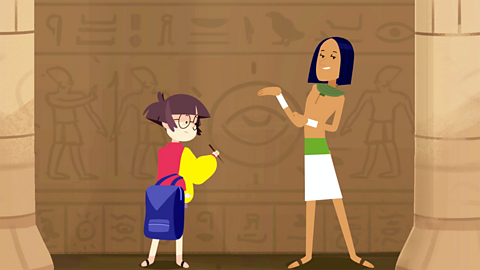
- count2 of 18
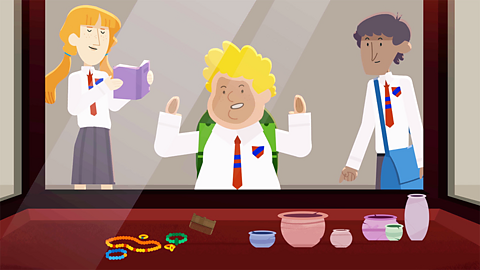
- count3 of 18
